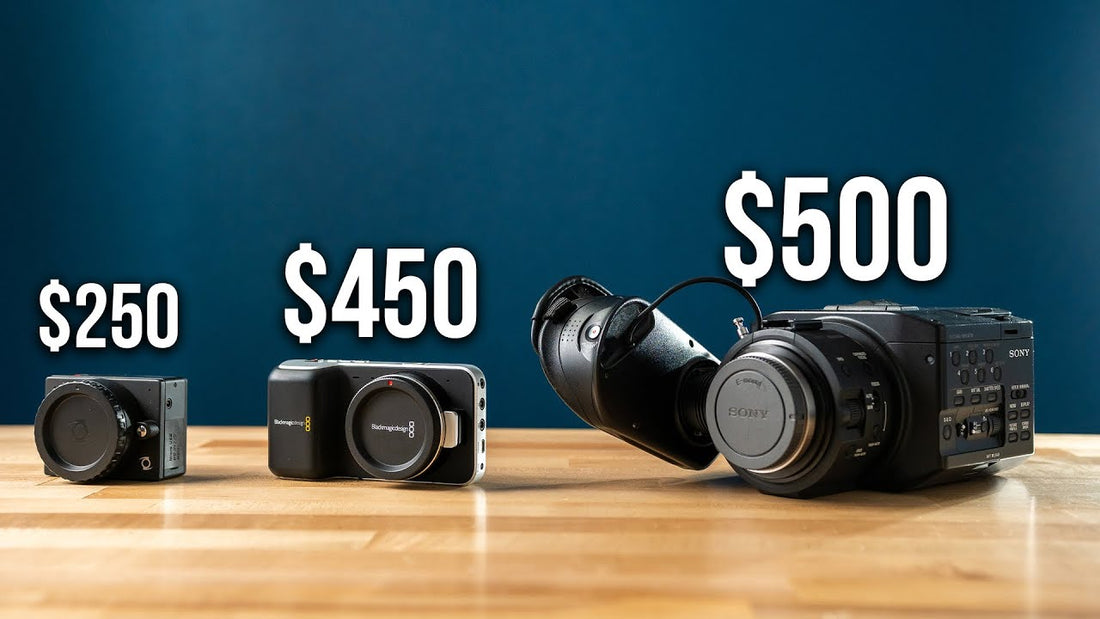
Best Budget Cinema Camera Under $500 | Head To Head Comparison
Check out my full video HERE
This post contains affiliate links. If you click and make a purchase, I may earn a commission at no extra cost to you. Thanks for your support!
Introduction
Finding a genuine “cinema camera” under $500 might sound impossible, but after digging deep into the used market and scouring for hidden gems, we’ve found three candidates worth discussing. In this comprehensive comparison, we’ll stack up three budget-friendly cinema-oriented cameras side-by-side, test their strengths and weaknesses, and see which one offers the best value for filmmakers on a shoestring budget.
The three cameras on our list are:
- Sony FS100: A once-$5,000 professional Super 35 cinema camera now available for around $500.
- Z Cam E1: The smallest 4K interchangeable-lens camera from Z Cam, hovering around $250-$400 used.
- Blackmagic Pocket Cinema Camera (Original): The classic HD pocket cinema camera from Blackmagic, often found for $400-$600.
While all three can produce great-looking footage, their core features and ergonomics differ drastically. By the end of this breakdown, you’ll know which one fits your style—whether that’s run-and-gun documentary work, narrative filmmaking, or something in between.
Camera Introductions and Price Points
Sony FS100 (Approx. $450-$650)
- Released: 2011
- Sensor: Super 35 (1.5x crop), Sony E-mount
- Key Specs: 1080p up to 60 fps, tons of physical controls, professional audio inputs (XLR)
- Originally $5,000, now easily found for under $500. Perfect for those who value a true cinema form factor and professional build.
Z Cam E1 (Approx. $250-$450)
- Released: 2016
- Sensor: Micro Four Thirds (2x crop), MFT mount
- Key Specs: 4K DCI 24p, UHD 30p, 1080p 60p, and even a 720p 240fps mode
- Originally $700, now much cheaper. Incredibly small, but limited ergonomics and no advanced log profile that’s truly usable.
Blackmagic Pocket Cinema Camera (Original) (Approx. $400-$600)
- Released: 2013
- Sensor: Super 16 (2.88x crop), MFT mount
- Key Specs: 1080p up to 30 fps in ProRes or CinemaDNG RAW, producing 10-bit 422 or 12-bit RAW footage
- Originally $1,000, now a serious bargain. Known for its cinematic image quality and professional codecs.
Video Specs & Codex
-
FS100:
- 1080p up to 60 fps (AVCHD, 4:2:0 8-bit)
- About 24 Mbps at 24p
- Customizable picture profiles
- Good for straightforward projects, but no RAW or 10-bit options.
-
Z Cam E1:
- DCI 4K 24p, UHD 4K 30p, 1080p 60p, 720p 240p
- H.264, 4:2:0 8-bit; about 60 Mbps in 4K mode
- Basic Rec.709 profile recommended (Z-Log2 is unstable in this codec)
- More resolution and frame rate flexibility, but less dynamic range.
-
Blackmagic Pocket Cinema Camera:
- 1080p at 24/30p only
- ProRes (Proxy/LT/422/HQ) or CinemaDNG RAW
- RAW: 12-bit; ProRes: 10-bit 4:2:2
- Exceptional flexibility in post, similar to higher-end cinema workflows.
Bottom Line:
If you need high-resolution options and slow motion, the E1 stands out. If you crave RAW or high-bit-depth ProRes for extensive color grading, the Blackmagic is king. The FS100 sits comfortably in the middle with reliable full HD and decent picture profiles.
Ergonomics & Usability
-
FS100:
- Professional body: top handle, side grip, dedicated audio controls, fully articulating screen.
- Two XLR inputs for professional audio.
- Tons of physical buttons and dials—no menu diving for basic adjustments.
- Feels like a true cinema camera right out of the box.
-
Z Cam E1:
- Tiny, cube-like body with minimal buttons.
- Difficult to adjust settings quickly (no touchscreen, minimal controls).
- Best suited for mounting in a rig or on a gimbal.
- Feels more like an action camera with a lens mount than a cinema camera.
-
Blackmagic Pocket Cinema Camera:
- Small, DSLR-like form factor with a basic grip.
- Buttons for menu navigation, but still some menu diving required.
- Poor internal battery life (external battery solutions recommended).
- Feels like a pocket-sized cinema tool that demands a rig for serious work.
Bottom Line:
For comfort and run-and-gun scenarios, the FS100 wins with flying colors. The Blackmagic is workable but benefits from rigging. The E1, while discreet, is too minimal for quick adjustments.
Video Assist Features
- FS100: Zebras, histogram, peaking, focus magnification—professional-level monitoring tools.
- Z Cam E1: Almost nothing but a basic magnification. Very hard to nail exposure and focus.
- Blackmagic Pocket: Has focus peaking, zebras, and a histogram. Not as complete as FS100 but significantly better than E1.
Bottom Line:
FS100 and Blackmagic offer real assist tools. E1 leaves you guessing.
ISO & Low-Light Performance
- FS100: Native ISO ~500. Clean up to ISO 1600; even 3200 is usable with mild noise reduction. Great low-light option.
- Z Cam E1: Best kept at ISO 100-200. Anything above introduces heavy noise. Not ideal for low-light.
- Blackmagic Pocket: Base ISO 800. Usable between 200-800. ISO 1600 is borderline but can work in a pinch.
Bottom Line:
FS100 excels in low light; Blackmagic is decent; E1 struggles badly.
Autofocus & Rolling Shutter
- Autofocus: All three are weak by modern standards. FS100’s autofocus is slightly more dependable for static shots, but none should be relied on for critical work.
-
Rolling Shutter:
- FS100: Lowest rolling shutter, more stable.
- Blackmagic: Moderate, noticeable but manageable.
- E1: Quite pronounced skew and wobble.
Bottom Line:
If you must have minimal jello effect, FS100 leads the pack again.
Audio Capabilities
- FS100: Two XLR inputs, headphone out, on-body controls for levels, phantom power—truly professional.
- Z Cam E1: Single 3.5mm mic input, no audio adjustments. Limited and impractical for serious audio.
- Blackmagic Pocket: 3.5mm mic and headphone jacks, basic menu-based gain control. Better than E1, but not as good as FS100.
Bottom Line:
FS100 is the clear winner for audio. The Blackmagic is workable; E1 is minimal.
Which Should You Choose?
-
Sony FS100:
- Best for: Run-and-gun filmmaking, corporate/wedding videos, documentaries, and any scenario where quick setting changes and reliable audio are crucial.
- Strengths: Professional ergonomics, good low-light, XLR audio, easy controls.
- Weaknesses: Limited to 1080p, basic codec.
-
Z Cam E1:
- Best for: Specialty rigs, gimbal or drone use where size trumps usability, and scenarios where 4K resolution matters most.
- Strengths: Tiny form factor, 4K DCI, can shoot 240fps at 720p.
- Weaknesses: Poor ISO performance, no assist tools, awkward handling, weak codec flexibility.
-
Blackmagic Pocket Cinema Camera (Original):
- Best for: Narrative short films, music videos, and passion projects where you can light and control the environment. Perfect if you want RAW or ProRes flexibility in post.
- Strengths: Cinematic image, RAW/ProRes codecs, easy color grading.
- Weaknesses: Weak battery life, limited frame rates/resolution, not ideal for run-and-gun.
Final Verdict
-
Run-and-Gun / Corporate / Event Work: Sony FS100 is your best bet. It’s a true cinema camera built for on-the-fly adjustments and professional audio handling.
-
Narrative / Creative Projects: Blackmagic Pocket Cinema Camera delivers the most cinematic, gradable footage. If you have time and can control your shoot, it’s a gem.
-
Specialty Shots / Gimbals / Ultra-Budget: Consider the Z Cam E1 only if you need 4K in a tiny package and can work around its limitations.
Conclusion
Finding a sub-$500 cinema camera is tough, but not impossible. The Sony FS100 offers professional handling on a budget. The Blackmagic Pocket Cinema Camera brings unparalleled codec quality for narrative work. The Z Cam E1, while not a perfect cinema tool, offers 4K and compactness at rock-bottom prices.
Whichever you choose, remember that lighting, sound, and storytelling matter far more than any camera body. But if you’re determined to grab a piece of cinema history at a bargain, these three options prove that even with $500, you can punch well above your weight class in professional filmmaking.
